Although it may not matter who orders the bottle of wine, a person may try to impress their date by showing they know their way around wine even though they may not. There are some women that may prefer their date to order the wine similar to having their chair pushed in or the door opened for them. No matter the reason for ordering wine, there are a few strategies for getting the job done.
Read Up
By taking a few minutes to look at a book or magazine, it is easy to understand the basics of wine and which bottles will taste good with each meal. The internet will have several resources and it is easier to find exactly what you want to know. After reading up on some information, it is time to hit the restaurant.
Switch it Up
When the waiter comes to the table they will usually ask you want something to drink such as a glass of wine. Rather than ordering a bottle right away, ask your date if she would drink a glass of Champagne with you. If you date is agrees you can ask for two glasses of sparkling wine. This will give you time to look over the menu and be able to pair the wine and the meal together.
Get a bottle
Rather than ordering a few glasses of wine, purchase a bottle. A bottle will be more romantic for your date. Typically at a wine restaurant, it is cheaper to order a bottle of wine than four glasses of wine. It may look like money does not matter, when in fact you are saving money.
Take Time and Order
Look over the wine list slowly. It will show that you actually care about the right bottle rather than getting the best deal. It will also give your date the impression that you know a lot about wine. It may even be a good idea to stay away from bottles costing less than $25. Ask your date if she prefers red or white wine. There are two types that are very flexible with any food. If she says white, order a Riesling. If she says red, order a Pinot Noir.

Memorial Wine Cellar is continually eveling their collection based upon the palates of guests. This is a great wine restaurant to take your date for that special occation. Memorial Wine Cellar has curbside service for picking up wine and they always offer a high level of customer service.







